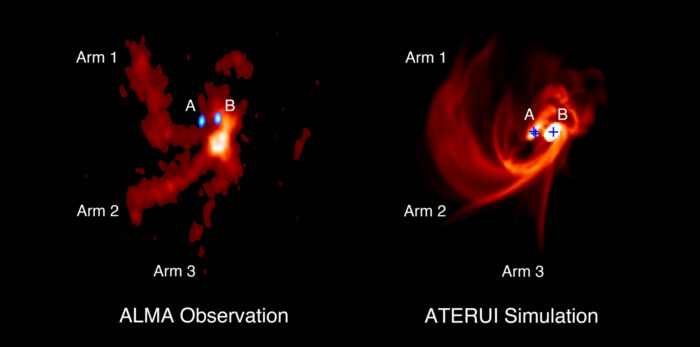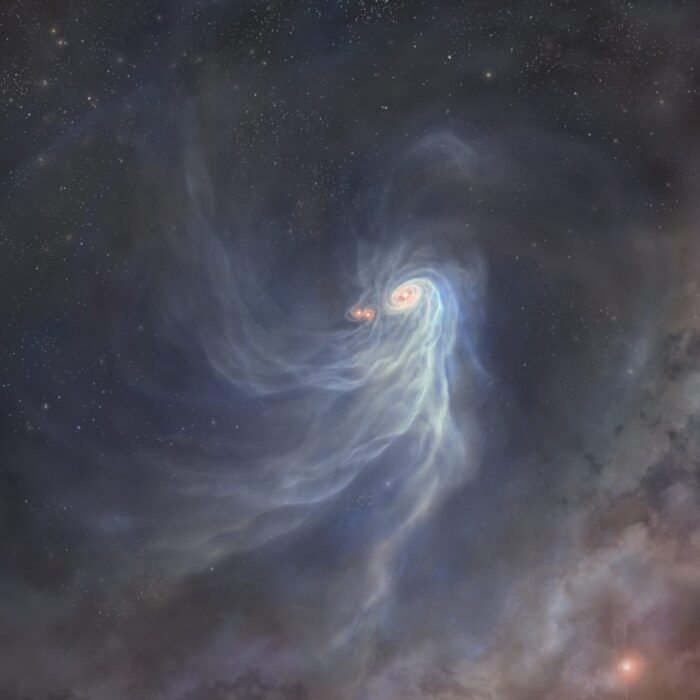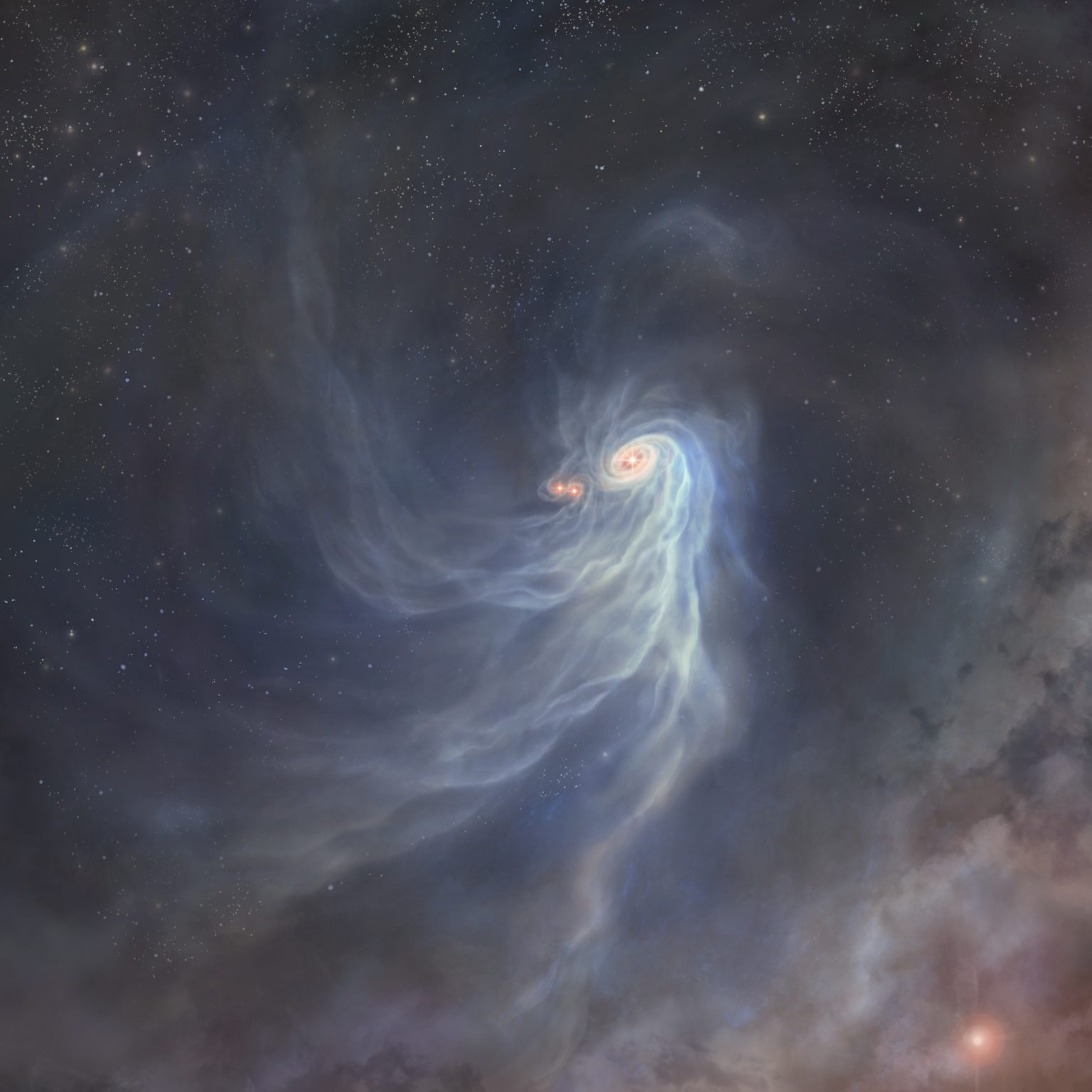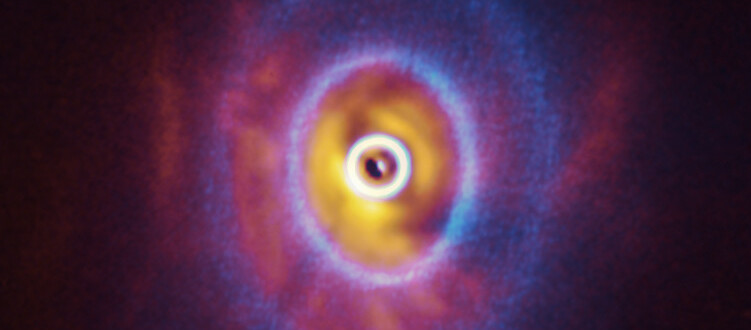Triple Star Birth: Unraveling the Mystery with ALMA
Peering into the complexities of star creation, an international research team has unveiled striking insights about the formation of triple star systems. Led by Professor Jeong-Eun Lee from Seoul National University, the team turned to the Atacama Large Millimeter/submillimeter Array (ALMA) to investigate the intricate gas structure surrounding the protostars in the triple system, IRAS 04239+2436. Through their study, they picked up the radio signals of sulfur monoxide (SO) molecules, akin to hearing a whisper in a bustling crowd. These signals acted like cosmic breadcrumbs, leading the team to the discovery of three colossal spiral arms. These arms were found to serve as 'streamers,' a cosmic conveyor belt transporting material to the newborn stars. By juxtaposing their observations with numerical simulations led by Professor Tomoaki Matsumoto from Hosei University, the team uncovered the mysterious origins of these streamers. This marks the first time we've understood how these streamers form amidst the dynamic dance of star formation, shedding light on a process as enthralling as it is complex.
Stars don't always shine alone. In fact, over half of them are born as part of multiple-star systems. But exactly how these multiple stars come into being is a mystery that scientists have long been trying to solve. Therefore, solving the mystery of the formation mechanism of multiple stars is very important for a comprehensive theory of star formation. So far, there have been several proposed scenarios for multiple star formation, and the discussions about the formation scenarios have not yet converged. To understand the process of multiple star formation, it is necessary to directly observe the moment when multiple protostars (forming stars) are born, with the high resolution and sensitivity of a facility like ALMA.
Furthermore, recently, scientists observing these baby stars, or protostars, noticed something intriguing. They saw structures made of gas, which they dubbed 'streamers.' These cosmic rivers flow and carry vital materials straight towards the protostars. Observing the streamers is crucial because they show how protostars absorb gas to grow, but how these streamers form is still unclear. Since the gas flows around the protostars of multi-star systems are expected to have a complex structure, detailed observation with the high resolution of ALMA is a powerful tool to investigate the origin of the streamers.
The team used ALMA to observe the radio waves emitted by sulfur monoxide (SO) molecules around the young multiple star system IRAS 04239+2436. IRAS 04239+2436 is a "trinary protostar system," i.e., a system consisting of three protostars located about 460 light-years away from us. The research team was expecting to detect SO molecules in the area where shock waves are present and to see violent gas motion around the protostars. As a result of the observations, they detected SO molecules around the triple protostars. They discovered that the distribution of SO molecules forms large spiral arms extending up to 400 astronomical units. Moreover, they successfully obtained the velocity of the gas containing SO molecules based on the frequency shift of radio waves due to the Doppler effect.
According to the analysis of the gas motion, it was found that the spiral arms traced by SO molecules are indeed streamers flowing toward the triple protostars. "The most profound feature of our ALMA images is the well-delineated large multiple-arm structures detected in the SO emissions," says Lee, explaining the significance of this discovery. "My first impression was that the structures were dancing together, spinning around the central protostellar system, although we later found that the spiral arms are channels of material feeding the baby stars."
To investigate the gas motion further, the team compared the observed gas velocity with numerical simulations that model multiple star formation within a natal gas cloud. These simulations were conducted using "ATERUI" and "ATERUI II" [1], supercomputers dedicated to astronomy in the Center for Computational Astrophysics at the National Astronomical Observatory of Japan (NAOJ). In the simulation, three protostars form in the gas cloud, and the gas disturbed around the triple protostars excites shock waves in the form of spiral arms. "We found that the spiral arms exhibit gas flows toward the triple protostars; they are streamers supplying gas to the protostars," says Matsumoto, who led the numerical simulations in this research. "The velocity of the gas derived from the simulations and the observations matches well, indicating that the numerical simulation can indeed explain the origin of the streamers."
The research team investigated how this triple protostar was born by comparing the observations with the numerical simulations. Until now, two scenarios have been proposed for forming multiple stars. The first is the 'turbulent fragmentation scenario,' in which the turbulent gas cloud fragments into gas condensations, each evolving into a protostar. The second is the 'disk fragmentation scenario,' where the gas disk surrounding a protostar fragment forms a new protostar, leading to multiple stars. The triple protostar observed here can be explained by a hybrid scenario in which the star formation process starts as a turbulent natal gas cloud, similar to the turbulent fragmentation scenario. Then, the seeds of new protostars are produced in the disk, like in the disk fragmentation scenario, and the surrounding gas turbulence causes the spiral arms to extend widely. The observational results are very similar to the simulation results, indicating that the observed triple protostars are the first objects confirmed to demonstrate the formation of multiple stars by a hybrid scenario. Matsumoto says, "This is the first time that the origin of protostars and the streamers have been simultaneously and comprehensively clarified. The powerful synergy between ALMA's observations and advanced simulations is revealing the hidden mysteries of star formation."
Lee suggests that this study also sheds light on the difficulty of planet formation in multiple star systems. She says, "Planets are born in gas and dust disks that form around protostars. In the case of this triple protostar system, the protostars are located within a small area, the disks around the protostars are small, and orbiting protostars strip the disks from other protostars. Planets form in a calm environment over a long period. Therefore, it is unlikely that IRAS 04239+2436 is a conducive environment for forming planets."
Matsumoto discusses the impact of this study on our understanding of multiple star formation. "The actual observation of a multi-star system in formation through the hybrid scenario will significantly contribute to resolving debates over multiple star formation scenarios. Furthermore, this research confirmed the recently noticed streamers' existence and explained how they formed, marking a significant advancement."
Note
[1] "ATERUI" and "ATERUI II": NAOJ's supercomputers dedicated to numerical simulations in astronomy, operated by CfCA at NAOJ Mizusawa Campus (Oshu City, Iwate Prefecture). ATERUI (Cray XC30) was in operation from 2013 to 2018, with a theoretical peak performance of 1.058 petaflops (1 petaflops represents a performance of one quintillion calculations per second). ATERUI II (Cray XC50) has been in operation since 2018, and its theoretical peak performance of 3.087 petaflops makes it the world's fastest supercomputer dedicated to astronomy.
Additional Information
This research was presented in a paper "Triple spiral arms of a triple protostar system imaged in molecular lines" by Jeong-Eun Lee et al. in the Astrophysical Journal on August 4, 2023 (doi: 10.3847/1538-4357/acdd5b.).
This work is supported by the National Research Foundation (NRF) of Korea grant funded by the Republic of Korea government Ministry of Science and ICT (MSIT) (grant number 2021R1A2C1011718), the Ministry of Education of Taiwan (grant number 110J0353I9), the Ministry of Science and Technology of Taiwan (grant number 111B3005191), and JSPS KAKENHI (grant numbers JP17K0539, JP18H05437, JP20H05645, JP23K03464).
This Press Release is based on the original one published by the National Astronomical Observatory of Japan (NAOJ), an ALMA partner on behalf of East Asia.
The Atacama Large Millimeter/submillimeter Array (ALMA), an international astronomy facility, is a partnership of the European Organisation for Astronomical Research in the Southern Hemisphere (ESO), the U.S. National Science Foundation (NSF) and the National Institutes of Natural Sciences (NINS) of Japan in cooperation with the Republic of Chile. ALMA is funded by ESO on behalf of its Member States, by NSF in cooperation with the National Research Council of Canada (NRC) and the National Science and Technology Council (NSTC) in Taiwan, and by NINS in cooperation with the Academia Sinica (AS) in Taiwan and the Korea Astronomy and Space Science Institute (KASI).
ALMA construction and operations are led by ESO on behalf of its Member States; by the National Radio Astronomy Observatory (NRAO), managed by Associated Universities, Inc. (AUI), on behalf of North America; and by the National Astronomical Observatory of Japan (NAOJ) on behalf of East Asia. The Joint ALMA Observatory (JAO) provides the unified leadership and management of the construction, commissioning, and operation of ALMA.
Images


Video
Contacts
-
Nicolás Lira
Education and Public Outreach OfficerJoint ALMA Observatory, Santiago - ChilePhone: +56 2 2467 6519Cel: +56 9 9445 7726Email: [email protected] -
Naoko Inoue
EPO officer, ALMA ProjectNational Astronomical Observatory of Japan (NAOJ)Email: [email protected] -
Bárbara Ferreira
ESO Media Manager -
Jill Malusky
Public Information Officer




